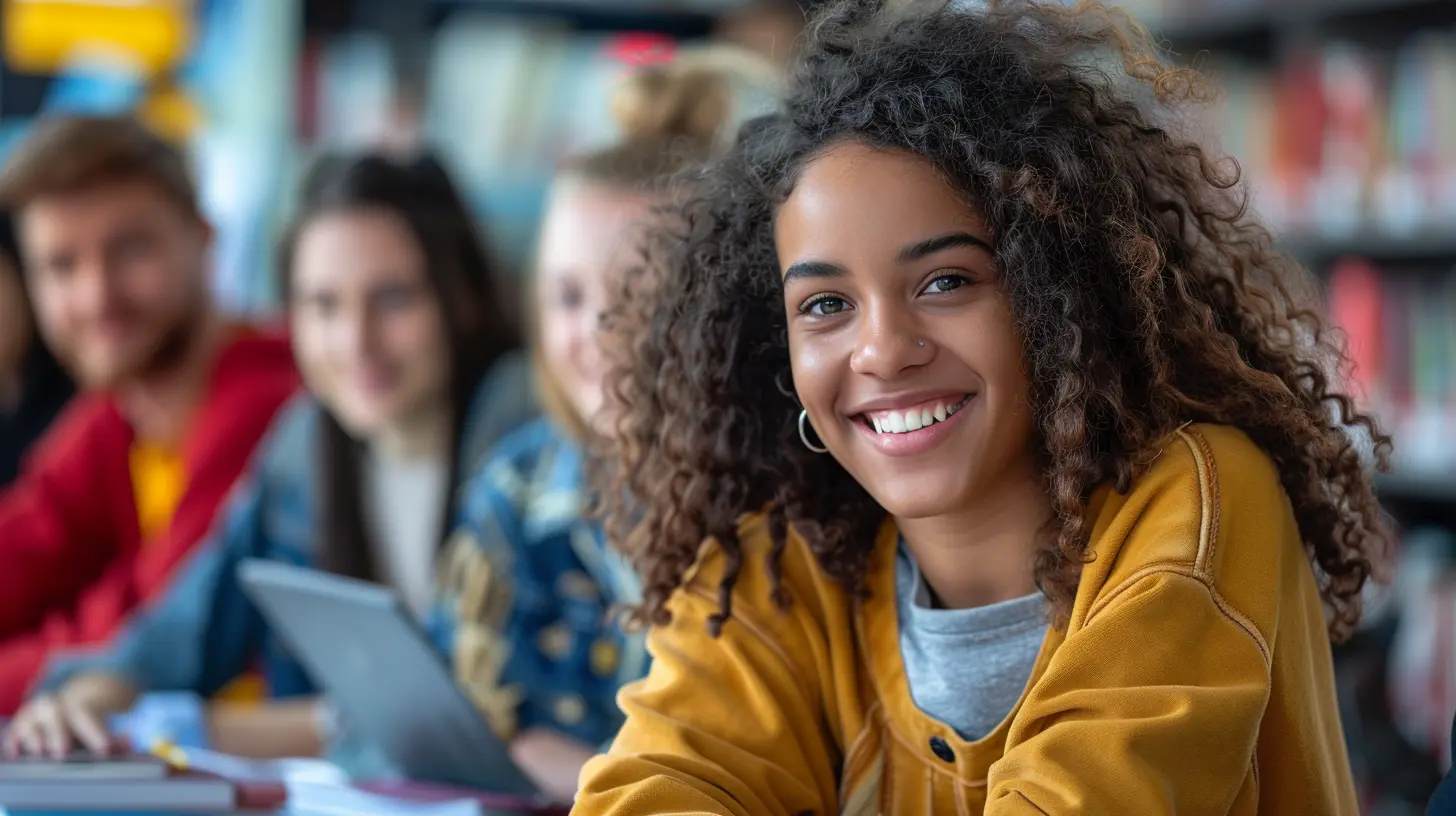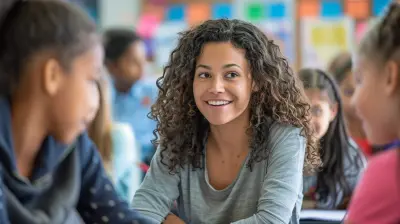The Role of Active Learning in Keeping Students Engaged
23 November 2024
In today's fast-paced world, traditional methods of teaching seem to be losing their mojo. You know, the old-school "sit still, listen, and take notes" approach just doesn't cut it for many students anymore. It's like expecting someone to stay awake during a boring documentary when there's a blockbuster movie playing in the next room. So, what’s the solution? Enter active learning – a teaching approach that’s shaking things up and keeping students on their toes. But what exactly is active learning, and why is it so crucial in keeping students engaged? Let's dive in!

What is Active Learning?
Before we dig deeper, let’s break down what active learning actually means. Think of it as the opposite of passive learning, where students are mere spectators in the learning process. Instead of just sitting back and absorbing information (or at least trying to), active learning encourages students to participate, interact, and engage with the material.It’s more about doing than observing. It’s like learning to ride a bike. You can watch someone cycle all day long, but until you hop on the bike yourself, you won’t get the hang of it. Active learning involves strategies like group discussions, problem-solving activities, hands-on experiments, role-playing, and even debates. It’s all about getting your brain in gear and taking learning for a spin.

Why is Engagement So Important?
Let’s be real for a second. Engagement isn’t some fancy buzzword thrown around by educational theorists for fun. It’s the backbone of effective learning. When students are engaged, they’re not just paying attention – they’re actively thinking, questioning, and applying the information they’re learning.Think of it this way: imagine being at a party where you know everyone, the music's great, and the conversations are lively. You’re involved, you’re having fun, and you’re likely to stay a long time. Now, picture a boring, corporate meeting where you’re not interested in the topic, and your mind keeps drifting to what you’ll have for dinner. In the second scenario, you’re disengaged, and you can’t wait to leave. That’s how students feel when they aren’t engaged in the classroom. And if they’re not engaged, they’re not learning.

The Science Behind Active Learning
There’s actual science backing the importance of active learning. Studies show that when students are actively involved in the learning process, they retain information better. In fact, according to a study conducted at Harvard, students in active learning environments scored higher on tests compared to those in traditional lecture-based settings.Why? Because active learning taps into how our brains are wired to work. When we're involved in a hands-on task, we engage multiple parts of the brain. This helps solidify the information and create stronger neural connections. Essentially, the more senses and cognitive functions we use, the better we remember.
Let’s use an analogy. Think of your brain as a garden. If you plant a seed (new information) and only water it once (passive learning), it might sprout, but it’s unlikely to grow strong. On the other hand, if you water it regularly, give it sunlight, and tend to it (active learning), it flourishes. Active learning is that consistent “tending” that helps new knowledge grow.

Different Types of Active Learning Strategies
Active learning isn’t a one-size-fits-all approach. There are various strategies teachers can use, depending on the subject matter, the students’ learning styles, and the classroom environment. Let’s take a look at some popular active learning techniques:1. Group Discussions and Peer Teaching
This strategy involves students discussing topics in small groups or pairs. Sometimes, they even take turns teaching each other. Why does this work? Because explaining concepts to others forces students to understand the material deeply. Plus, students often feel more comfortable asking questions in smaller groups rather than in front of the entire class.2. Problem-Based Learning (PBL)
In this method, students are presented with real-world problems and must work together to find solutions. Rather than spoon-feeding information, the teacher acts more like a guide, encouraging critical thinking and collaboration. This method is particularly effective because it mirrors real-life situations, where answers aren’t always clear-cut, and teamwork is essential.3. Interactive Simulations and Role-Playing
Here, students are placed in simulated environments or scenarios where they must apply their knowledge. For example, in a history class, students might re-enact a famous historical event, or in a science class, they could simulate a chemical reaction. Role-playing allows students to see the material in action, making abstract concepts more tangible.4. Think-Pair-Share
This is a quick and easy way to get students involved. First, students think about a question or problem on their own. Then, they pair up with a classmate to share their thoughts. Finally, the pairs present their ideas to the larger group. This strategy gives students time to process the material, collaborate, and then articulate their understanding.5. Flipped Classroom
In a flipped classroom, students are given materials (videos, articles, etc.) to review before class. Then, during class, they engage in discussions, activities, or projects based on that material. This shifts the focus from passive learning (listening to a lecture) to active learning (applying the material). It’s like doing your homework in class and saving the lectures for home.Benefits of Active Learning
Okay, so we’ve established what active learning is and how it can be implemented, but what about the benefits? Why should educators bother switching things up? Let’s break it down:1. Improved Retention and Understanding
As we mentioned earlier, active learning leads to better retention of information. When students are engaged in hands-on activities, they’re more likely to remember what they’ve learned. Plus, applying the information in different contexts (through discussions, problem-solving, etc.) helps deepen their understanding.2. Encourages Critical Thinking
Active learning doesn’t just ask students to memorize facts; it challenges them to think critically. By analyzing problems, debating different perspectives, and working through real-world scenarios, students develop problem-solving skills that are crucial both in and out of the classroom.3. Boosts Collaboration and Communication Skills
Many active learning strategies involve group work, which promotes collaboration. Students learn how to communicate effectively with their peers, listen to different viewpoints, and work as part of a team. These are essential skills that will serve them well in the workforce and beyond.4. Increases Motivation and Interest
Let’s face it – students are more likely to be motivated when they’re actively engaged. When learning feels interactive and relevant, they’re more likely to take ownership of their education. Suddenly, school goes from being a chore to something they actually look forward to.5. Personalized Learning
Active learning also allows for more personalized learning experiences. Students can work at their own pace, explore topics that interest them, and collaborate with others who might have similar learning styles. This makes the learning experience more tailored and less one-size-fits-all.
Potential Challenges of Active Learning
Of course, like any teaching method, active learning comes with its challenges. For one, it requires more preparation from teachers. Crafting interactive lessons, coming up with activities, and managing group work can be time-consuming. Additionally, some students might resist active learning at first, especially if they’re used to more passive methods.There’s also the issue of class size. Active learning activities can be harder to manage in larger classrooms, where it’s difficult to give each student the attention they need. However, with the right planning and resources, these challenges can be overcome.
How to Implement Active Learning in Any Classroom
If you’re a teacher looking to implement more active learning strategies in your classroom, the good news is that you don’t have to overhaul your entire teaching style. Start small. For instance, you could incorporate a brief group discussion or problem-solving activity into your existing lessons. Gradually, as you and your students become more comfortable with the approach, you can increase the amount of active learning.Also, don’t be afraid to ask your students for feedback. What activities do they enjoy? What helps them learn best? Active learning is all about engagement, so keep the lines of communication open and adjust your strategies accordingly.
Wrapping Up
At the end of the day, active learning is about making education a more dynamic, interactive process. It’s about moving away from the traditional "chalk and talk" method and towards a more engaging, student-centered approach. By involving students in the learning process, we can help them not only better understand the material but also develop critical thinking, collaboration, and problem-solving skills that will serve them for life.So, whether it’s through group discussions, problem-solving activities, or role-playing, the key is to keep students active in their learning. After all, no one wants to be a passive passenger on the journey to knowledge – we all want to be in the driver’s seat.
all images in this post were generated using AI tools
Category:
Student EngagementAuthor:

Zoe McKay
Discussion
rate this article
19 comments
Nala Phelps
Active learning transforms education by fostering engagement and curiosity. When students participate actively, they not only absorb knowledge but also develop critical thinking and collaboration skills, paving the way for a brighter, more innovative future. Embrace the power of engagement!
January 29, 2025 at 3:47 AM

Zoe McKay
Thank you! I completely agree—active learning truly enhances engagement and cultivates essential skills for students' futures. Let's keep advocating for these transformative practices!
Soryn McGhee
Active learning is essential for fostering student engagement. By promoting collaboration, critical thinking, and hands-on experiences, educators can create dynamic classroom environments. This approach not only enhances understanding but also motivates students to take ownership of their learning, leading to deeper connections with the material and improved academic outcomes.
January 25, 2025 at 9:15 PM

Zoe McKay
Thank you for your insightful comment! I completely agree that active learning significantly boosts student engagement and fosters a deeper connection to the material.
Quinn Hughes
Great insights! Active learning truly fosters engagement; incorporating diverse strategies can enhance student participation even further.
January 23, 2025 at 4:14 AM

Zoe McKay
Thank you! I completely agree—diversifying strategies is key to maximizing engagement in active learning.
Lys Myers
Active learning not only fosters engagement but also empowers students to take ownership of their education, cultivating critical thinking and collaboration skills essential for lifelong learning.
January 20, 2025 at 8:46 PM

Zoe McKay
Thank you for highlighting the transformative power of active learning! It truly empowers students and enhances essential skills for their lifelong educational journey.
Nadine Patel
In the garden of minds, where curiosity blooms, Active learning's gentle breeze dispels the glooms. Engagement’s dance, a vibrant song, Ignites the spark, where students belong. Through hands-on joys and questions that inspire, We weave a tapestry of knowledge, ever higher. Let learning’s light never tire.
January 17, 2025 at 8:50 PM

Zoe McKay
Thank you for your beautiful words! They perfectly capture the essence of active learning and its impact on student engagement.
Adeline Hardy
Active learning boosts engagement through participation.
January 16, 2025 at 3:19 AM

Zoe McKay
Absolutely! Active learning fosters student engagement by encouraging direct participation, making the learning process more interactive and dynamic.
Flora Oliver
Active learning isn't just a trend—it's a necessity. If we want to inspire real curiosity and foster critical thinking, we must ditch outdated lecture methods and embrace dynamic, student-centered approaches. Let's get bold!
January 10, 2025 at 9:37 PM

Zoe McKay
Absolutely! Active learning is essential for sparking curiosity and enhancing critical thinking. Embracing innovative, student-centered methods is key to engaging today's learners. Let's lead the change!
Tabitha White
Active learning transforms the classroom into a vibrant space of curiosity and collaboration! Embrace these interactive strategies to keep students engaged and excited about their learning journeys. Remember, every moment spent actively learning is a step towards success!
January 5, 2025 at 4:07 AM

Zoe McKay
Thank you for your insightful comment! I completely agree—active learning truly fosters curiosity and collaboration, making learning an exciting journey for students.
Tempest McLaurin
Active learning: a key that unlocks hidden potential in students. But what shadows linger behind traditional methods? Dive deeper into the intriguing dance between engagement and enlightenment in education.
December 30, 2024 at 4:47 AM

Zoe McKay
Thank you for your insightful comment! Traditional methods often stifle creativity and critical thinking, whereas active learning fosters deeper engagement and discovery, illuminating the path to true enlightenment in education.
Ardyn McCord
Active learning is a vital strategy for fostering student engagement. By promoting interaction and collaboration, it transforms the classroom into a dynamic environment where students can thrive. Embracing these techniques can truly make learning an enriching adventure for everyone involved!
December 27, 2024 at 12:34 PM

Zoe McKay
Thank you for highlighting the importance of active learning! I completely agree that it fosters engagement and creates a vibrant learning atmosphere.
Darrow Warner
Active learning sparks curiosity and fuels enduring engagement!
December 23, 2024 at 9:40 PM

Zoe McKay
Thank you! I completely agree—active learning not only ignites curiosity but also fosters long-lasting engagement in the learning process.
Kason Summers
Active learning is essential in today's classrooms, as it fosters student engagement and enhances critical thinking skills. By encouraging collaboration, hands-on activities, and real-world problem-solving, educators can create dynamic learning environments that inspire curiosity and deeper understanding among students.
December 18, 2024 at 5:55 AM

Zoe McKay
Thank you for your insightful comment! I completely agree that active learning significantly boosts engagement and critical thinking, creating vibrant classrooms that inspire students to explore and understand deeply.
Mae McGovern
Active learning transforms classrooms by fostering collaboration and critical thinking. Engaged students are more likely to retain information, develop problem-solving skills, and cultivate a lifelong love of learning.
December 14, 2024 at 12:13 PM

Zoe McKay
Thank you for your insightful comment! I completely agree that active learning not only boosts engagement but also enhances retention and fosters essential skills for lifelong learning.
Emery Strickland
Thank you for this insightful article! Active learning is indeed vital for student engagement. I appreciate the practical strategies you shared and look forward to implementing them in my teaching.
December 12, 2024 at 4:56 AM

Zoe McKay
Thank you for your kind words! I'm glad you found the strategies helpful. Best of luck in implementing them in your teaching!
Mira Kearns
This article beautifully highlights the importance of active learning in fostering student engagement. By prioritizing interactive methods, educators can cultivate curiosity and enthusiasm, making learning a dynamic and enjoyable journey. Let's inspire students to actively participate in their education!
December 7, 2024 at 7:59 PM

Zoe McKay
Thank you for your thoughtful comment! I'm glad you found the article highlights the significant impact of active learning on student engagement. Let's continue to inspire curiosity and participation in our classrooms!
Georgia Martinez
What a fantastic read! This article beautifully highlights the importance of active learning in fostering student engagement. By promoting hands-on experiences and interactive participation, we can create a vibrant learning environment that truly inspires curiosity and enthusiasm. Thank you for sharing these valuable insights!
December 1, 2024 at 7:37 PM

Zoe McKay
Thank you so much for your thoughtful feedback! I'm glad you found the article inspiring and valuable. Active learning truly makes a difference in student engagement!
Rocco McGuffey
Active learning fosters engagement by promoting collaboration and critical thinking, essential for deeper understanding and lasting retention.
November 28, 2024 at 8:39 PM

Zoe McKay
Thank you for your insightful comment! I completely agree—active learning truly enhances engagement through collaboration and critical thinking, leading to deeper understanding and better retention.
Violet McCune
Active learning fosters critical thinking and collaboration, essential for enhancing student engagement and retention.
November 28, 2024 at 4:42 AM

Zoe McKay
Thank you for highlighting the importance of active learning! I completely agree that it cultivates critical thinking and collaboration, which are vital for boosting student engagement and retention.
Ziva McIntire
This article sheds light on the fascinating impact of active learning in education! I'm curious about the specific techniques that have proven most effective in enhancing student engagement. How can we further integrate these strategies to create dynamic and inclusive learning environments for all students?
November 26, 2024 at 9:29 PM

Zoe McKay
Thank you for your interest! Some effective active learning techniques include collaborative group work, problem-based learning, and interactive technology. To further integrate these strategies, consider involving students in the design of activities and ensuring diverse representation in group settings to foster inclusivity.
MORE POSTS

Navigating Communication with Your Child’s Teachers

Peer Tutoring and Its Role in Promoting Equity in Education

The Role of Parents in Supporting Literacy Development

How to Engage Students with Different Learning Preferences

How to Challenge Gifted Students Without Overwhelming Them

The Role of Artificial Intelligence in Enhancing Virtual Classroom Experiences

Empowering Teachers to Take on Leadership Roles in Schools

Peer Tutoring: A Pathway to Academic Success

How to Enhance Online Learning with Collaborative Tools

Editing Tips to Polish Your Writing

Health Education for Young Children: Teaching the Basics Early

Using Reflective Teaching to Improve Classroom Practices